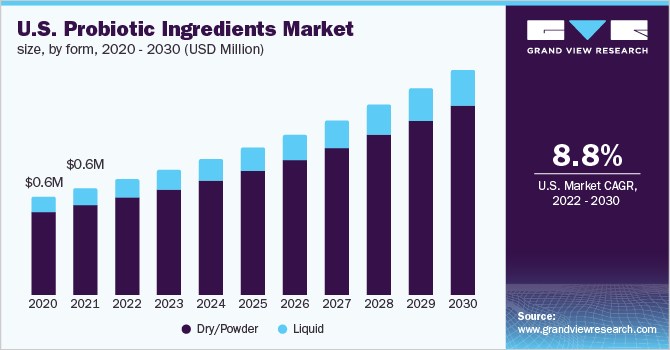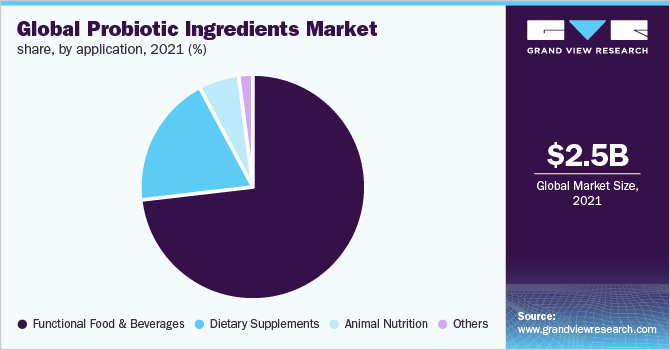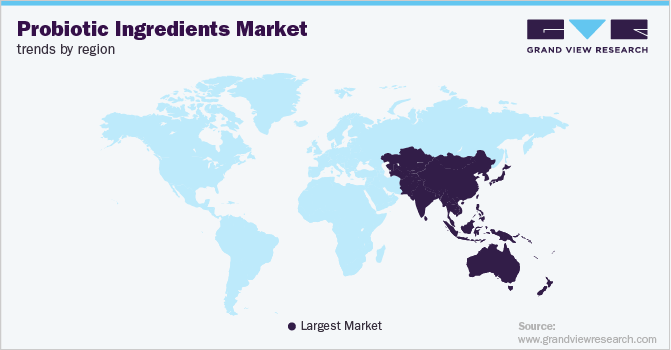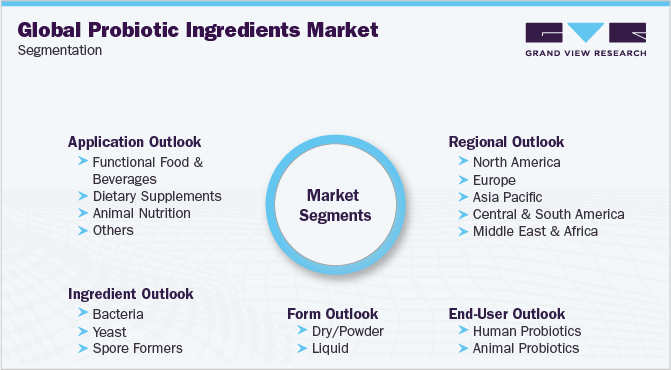
Probiotic Ingredients Market Size, Share & Trends Analysis Report By Form (Dry/Powder, Liquid), By Ingredient (Bacteria, Yeast, Spore Formers), By Application, By End-user, By Region, And Segment Forecasts, 2022 - 2030
- Report ID: GVR-1-68038-395-9
- Number of Report Pages: 150
- Format: PDF, Horizon Databook
- Historical Range: 2017 - 2020
- Forecast Period: 2022 - 2025
- Industry: Consumer Goods
Report Overview
The global probiotic ingredients market size was valued at USD 2.50 billion in 2021 and is expected to expand at a compound annual growth rate (CAGR) of 8.8% from 2022 to 2030. The growing use of probiotic ingredients in functional food & beverages due to their health benefits is projected to augment the demand for probiotic ingredients during the forecast period. In addition, due to the COVID-19 pandemic, different marketing techniques have been adopted by probiotic food manufacturers to promote their products in the market that enhance the immunity of consumers.

Probiotics are used for the prevention of conditions such as urinary tract infections, bacterial vaginosis, and oral health issues. Additionally, they can be used to prevent respiratory infections, necrotizing enterocolitis, and bowel disorders. An increase in awareness among the masses worldwide related to the consumption of healthy products is expected to drive the industry’s growth in the forthcoming years. Moreover, consumers are highly aware of the benefits of improved gut health.
Major markets for probiotic ingredients are concentrated in North America and Europe. Several countries, including the U.S., Italy, Spain, France, and the U.K. have been severely impacted by COVID-19. This has led to a growing demand for immunity-boosting products and probiotic supplements from consumers to improve their gut health. These products and supplements are being sourced by consumers from various channels such as supermarkets, hypermarkets, food stores, and drug stores & pharmacies. This huge surge in demand for immunity-based products has positively impacted the overall growth of the industry.
Medical research studies suggested that bifidobacterial and lactobacilli-based products not only decreased the duration of respiratory illnesses among individuals but also helped in curing other symptoms caused by the COVID-19 pandemic. According to several pieces of research, probiotics were used for aiding patients who were hospitalized with virus-related pneumonia.
The U.S. was the leading market in North America with a revenue share of 82.68% in 2021 and is expected to advance steadily at a CAGR of over 8.0% during the forecast period. Rising investment in research & development (R&D) by companies to develop new ingredients, coupled with the growing acceptance among consumers to pay a premium price for food products that contain probiotic ingredients, is anticipated to propel the industry growth.
The incorporation of probiotics in functional food products and beverages has increased in recent years as probiotics help to promote cognitive responses, improve immunity, and promote the general well-being of consumers. The dry/powder form of probiotic ingredients can also be used in a variety of end-use applications such as diary-based & cereal-based food and beverages as well as in non-dairy probiotic food and beverages, owing to its high compatibility with other ingredients. This factor is expected to propel the market growth.
Several well-characterized strains of lactobacilli and bifidobacteria are available for human consumption to reduce the risk of gastrointestinal infections or treat similar infections. The consumption of probiotics can repopulate the digestive tract with beneficial bacteria resulting in improved digestion management in humans. Thus, probiotics can help to maintain a healthy immune system by increasing lymphocytes.
Probiotics utilized in animal nutrition have received positive responses from farmers, pet owners, and cattle feeders. Animals have very complicated digestive systems owing to their unorganized eating habits, thus the inclusion of probiotics in feed helps to improve their gut health, boost immunity, and enhance overall performance.
Livestock-based food products not only provide high-value proteins but are also important sources of a wide range of essential micronutrients to consumers. Traditionally, antibiotics have been utilized as remedial measures to enable animals to fight against microbial infections, resulting in improved productivity and profitability for livestock owners.
However, concerns revolving around the negative effects of antibiotics on the entire food chain prevail worldwide. The European Union (EU) has already imposed a ban on the utilization of antibiotics as growth promoters in the animal feed industry. Probiotics in animal feed help enhance the resistance against pathogens, as well as enable the maintenance of the microbial flora in the intestinal tract of poultry animals, swine, and ruminants. Thus, the global animal feed industry has been increasingly adopting probiotics as an alternative to antibiotics for good animal health.
Form Insights
The dry/powder form of probiotic ingredients dominated the market, with a revenue of USD 2.09 billion in 2021, owing to the ease of storage, transport, and use provided by the dry/powder form of probiotic ingredients. Various freeze-drying and freezing techniques are used to produce the dry form. Even though these methods of production are regarded as effective in the field, manufacturing probiotic ingredients involves significant energy and transportation costs.
In the large-scale industrial production of powdered probiotic ingredients, spray drying is the most popular, effective, and economical process used across the globe. The spray drying process offers the fastest and safest way to manufacture encapsulated powdered probiotics.
The powder form of probiotic ingredients has witnessed a sudden surge in demand from dietary supplement manufacturers in the past few years, as it allows them to formulate probiotic supplements in various dosages including tablets, capsules, and powder forms. Increased applications in end-use industries and utilization benefits are likely to propel the demand for dry/powder probiotic ingredients across the globe.
The liquid form of probiotic ingredients is mainly used in animal feed such as beef, cattle, and sheep livestock industries. Liquid probiotic ingredients have been effective for livestock, as they improve feed intake, feed digestibility, and average daily gain of the livestock. Thus, increasing utilization and benefits provided by liquid probiotic ingredients are expected to boost segment growth across the globe.
Ingredient Insights
The bacteria segment dominated with a revenue of USD 2.13 billion in 2021. Extensive research on bacteria such as bifidobacterium and lactobacillus has been conducted in recent years; owing to this, the bacteria segment had witnessed significant growth. The strains of Lactobacillus, Lactococcus, Streptococcus, and Bifidobacterium are important components of bacteria-based probiotic ingredients. Among these, Lactobacillus is the most used bacterial strain in various end-use industries, which is expected to boost its growth.
Yeast-based probiotic strains have various applications in the food industry such as the production of specific enzymes and new bioactive peptides. Furthermore, they have been majorly used for the commercial production of yogurt and in the fermentation of vegetable products such as cabbage, beetroot, radish, and carrots. Thus, increasing potential applications of yeast-based probiotic strains in various industries are expected to boost the growth of the yeast segment during the forecast period. Spore production (sporulation) is induced by a wide range of environmental factors that inhibit cell growth, making sporulation a survival strategy.
End-user Insights
The human probiotics segment dominated the probiotic ingredients market and was valued at USD 2.34 billion in 2021 and is expected to expand steadily with a CAGR of over 8.0% during the forecast period. Traditionally, probiotic ingredients have been used in fermented food for a long time. Intake of Bifidobacterium and Lactobacillus species may enhance the health benefits of fermented foods.
Numerous studies have demonstrated probiotic effects on a wide range of gastrointestinal and extraintestinal disorders. This includes the prevention of antibiotic-associated diarrhea, traveler's diarrhea, lactose intolerance, inflammatory bowel disease, and protection against irritable bowel syndrome as well as intestinal infections. Thus rising research and the adoption of probiotic ingredients are expected to propel the growth.
The animal probiotics segment was valued at USD 154.6 million in 2021. Probiotic ingredients, which were previously only found in human food, have now been extended to animals through the development of fortified feed with added intestinal microbiota to support animal health. The microflora in animals' gastrointestinal tracts plays an important role in the regular digestion process and in maintaining overall animal health. Probiotics can assist in restoring the intestinal microbial balance of the host animal, thus driving growth.
Probiotics are increasingly being used in commercial animal feed manufacturing to improve animal health and productivity by altering gastrointestinal flora. The main benefits of using probiotics are increased growth, decreased mortality, and increased feed conversion efficiency in animals. These benefits are expected to fuel the industry’s growth.
Application Insights
The food & beverage segment held the highest revenue share of 73.18% in 2021 and is expected to witness a growth of over 8.0% during the projected period. Consumers across the globe are shifting towards probiotic ingredients owing to their role in preventing or treating digestive disorders, obesity, and other immunity-related issues.
Consumers prefer the intake of probiotic ingredients in various types of food and beverages, as taste is a primary concern for them. Increasing disposable income coupled with rising awareness about a healthy lifestyle is likely to promote the adoption of probiotic ingredients in various food and beverage items.

The demand for preventive healthcare has been increasing over the past few years owing to health awareness due to the pandemic and the increased cost of healthcare services across the globe. Gut health is directly related to immunity and people are increasingly adopting dietary supplements to increase or maintain their immunity.
Chronic diseases such as gastrointestinal diseases, cardiovascular diseases, and obesity are increasing among consumers due to lifestyle traits such as improper eating habits and sedentary routines. These factors are expected to increase the demand for probiotic ingredients in dietary supplements.
Animals have complex gut microbiota due to their unorganized eating habits which can lead to various digestive diseases in livestock and pet animals. The others segment includes applications of probiotic ingredients in agriculture. It is considered an emerging application of probiotic ingredients, as the rising adoption of it in agriculture is low and limited to a few developed economies.
However, the use of probiotic ingredients in plant health has high potential; thus, manufacturers of probiotic ingredients are investing more in this application segment.
Regional Insights
In terms of revenue, Asia Pacific is anticipated to witness the highest CAGR of 9.4% from 2022 to 2030. In the Asia Pacific, consumers are becoming more health-conscious and inclined towards products that offer both convenience and nutritional value; this factor is proving positive for the probiotic ingredients market growth in the foreseeable timeframe.
Digestive health and obesity are major health problems in the North American region, especially in the U.S. According to a research study conducted by American Gastroenterological Association (AGA) in 2020, more than 50% of the obese population in the U.S. includes probiotic dietary supplements in their weight management treatment to maintain their gut health. Thus, the increasing dependency of North American consumers on probiotic dietary supplements is expected to boost the demand for probiotic ingredients in the region.

Probiotic ingredients have witnessed a sudden surge in their demand in Europe over the past few years owing to the increasing popularity of probiotics to maintain gut health. The European market is estimated to reach USD 1,599.0 million in 2030. The U.K., Germany, and France are the key European probiotics markets. The presence of key players in the market and the ease of availability of products in the region are expected to boost product demand during the forecast period.
Key Companies & Market Share Insights
The probiotic ingredients industry has a large number of companies involved in the extraction and processing of probiotic ingredients from raw materials. Some of the major manufacturers include Kerry Inc., DSM, Associated British Foods plc, and Lallemand Inc., among others. Companies are establishing R&D with a technological rise in extracting and refining raw materials and are also adopting new technologies for food manufacturing.
The companies in the market are involved in strategic mergers & acquisitions, new product developments, and expansion activities in the area of introducing innovative food & beverage items, which is expected to fuel the demand for probiotic ingredients. For instance, in November 2020, Kerry Group acquired Quebec family-owned biotechnology company, Bio-K+ International Inc. With this acquisition, Kerry expanded its probiotic portfolio in the market. Some prominent players in the global probiotic ingredients market include:
-
Kerry Inc
-
Chr. Hansen Holding AS
-
DSM
-
DuPont de Nemours Inc
-
Associated British Foods plc
-
Lallemand Inc
-
Archer Daniels Midland
-
Advanced Enzyme Technologies
-
Probi AB
-
Adisseo
Probiotic Ingredients Market Report Scope
|
Report Attribute |
Details |
|
Market size value in 2022 |
USD 2.72 billion |
|
Revenue forecast in 2030 |
USD 5.33 billion |
|
Growth rate (Revenue) |
CAGR of 8.8% from 2022 to 2030 |
|
Base year for estimation |
2021 |
|
Historical data |
2017 - 2020 |
|
Forecast period |
2022 - 2030 |
|
Quantitative units |
Volume in Kilotons, Revenue in USD Million, and CAGR from 2022 to 2030 |
|
Report coverage |
Volume & Revenue forecast, company ranking, competitive landscape, growth factors, and trends |
|
Segments covered |
Form, ingredient, application, end-user, region |
|
Regional scope |
North America; Europe; Asia Pacific; Central & South America; Middle East & Africa |
|
Country scope |
U.S.; Canada; Mexico; U.K.; Germany; France; Italy; Spain; China; India; Japan; Australia; South Korea; Brazil; Argentina; South Africa; Saudi Arabia |
|
Key companies profiled |
Kerry Inc.; Chr. Hansen Holding AS; DSM (BioCare Copenhagen); DuPont de Nemours Inc. (IFF Nutrition & Bio-Science); Associated British Foods plc; Lallemand Inc.; Archer Daniels Midland (ADM) (Deerland Probiotics & Enzymes Inc); Advanced Enzyme Technologies; Probi AB; Adisseo |
|
Customization scope |
Free report customization (equivalent up to 8 analysts working days) with purchase. Addition or alteration to country, regional & segment scope. |
|
Pricing and purchase options |
Avail customized purchase options to meet your exact research needs. Explore purchase options |
Global Probiotic Ingredients Market Segmentation
This report forecasts volume and revenue growth at the global, regional, and country levels and provides an analysis of the latest industry trends and opportunities in each of the sub-segments from 2017 to 2030. For this study, Grand View Research has segmented the global probiotic ingredients market report based on form, ingredients, application, end-user, and region:

-
Form Outlook (Volume, Kilotons; Revenue, USD Million, 2017 - 2030)
-
Dry/Powder
-
Liquid
-
-
Ingredient Outlook (Volume, Kilotons; Revenue, USD Million, 2017 - 2030)
-
Bacteria
-
Lactobacilli
-
Bifidobacterium
-
Streptococcus
-
Other Genus
-
-
Yeast
-
Spore Formers
-
-
Application Outlook (Volume, Kilotons; Revenue, USD Million, 2017 - 2030)
-
Functional Food and Beverages
-
Dairy Products
-
Yogurt
-
Cheese
-
Others
-
-
Non-dairy Products
-
Bakery
-
Cereals
-
Functional Beverages
-
Others
-
-
-
Dietary Supplements
-
Chewables & Gummies
-
Capsules
-
Powders
-
Tablets
-
Soft Gels
-
Others
-
-
Animal Nutrition
-
Others
-
-
End-User Outlook (Volume, Kilotons; Revenue, USD Million, 2017 - 2030)
-
Human Probiotics
-
Animal Probiotics
-
-
Regional Outlook (Volume, Kilotons; Revenue, USD Million, 2017 - 2030)
-
North America
-
U.S.
-
Canada
-
Mexico
-
-
Europe
-
Germany
-
U.K.
-
France
-
Italy
-
Spain
-
-
Asia Pacific
-
China
-
India
-
Japan
-
Australia
-
South Korea
-
-
Central & South America
-
Brazil
-
Argentina
-
-
Middle East & Africa
-
South Africa
-
Saudi Arabia
-
-
Frequently Asked Questions About This Report
b. The global probiotic ingredients market size was estimated at USD 2.50 billion in 2021 and is expected to reach USD 2.72 billion in 2022.
b. The global probiotic ingredients market is expected to grow at a compound annual growth rate of 8.8% from 2022 to 2030 to reach USD 5.33 billion by 2030.
b. The Asia Pacific dominated the probiotic ingredients market with a share of 34.6% in 2021. This is attributable to the presence of major market participants in the region, high awareness regarding probiotic usage, and easy availability of products has benefited the regional demand in the recent past.
b. Some key players operating in the probiotic ingredients market include Probiotical S.p.A.; Ganeden, Inc.; Sabinsa Corporation; Biocodex, Inc.; BioGaia AB; Chr. Hansen Holding A/S; Danisco A/S; Danone, Inc.; and Lallemand, Inc.
b. Key factors that are driving the market growth include increasing consumer awareness regarding preventive healthcare coupled with increasing expenditure on probiotics, most notably in countries such as Japan, Germany, and U.K.
We are committed towards customer satisfaction, and quality service.
"The quality of research they have done for us has been excellent."




